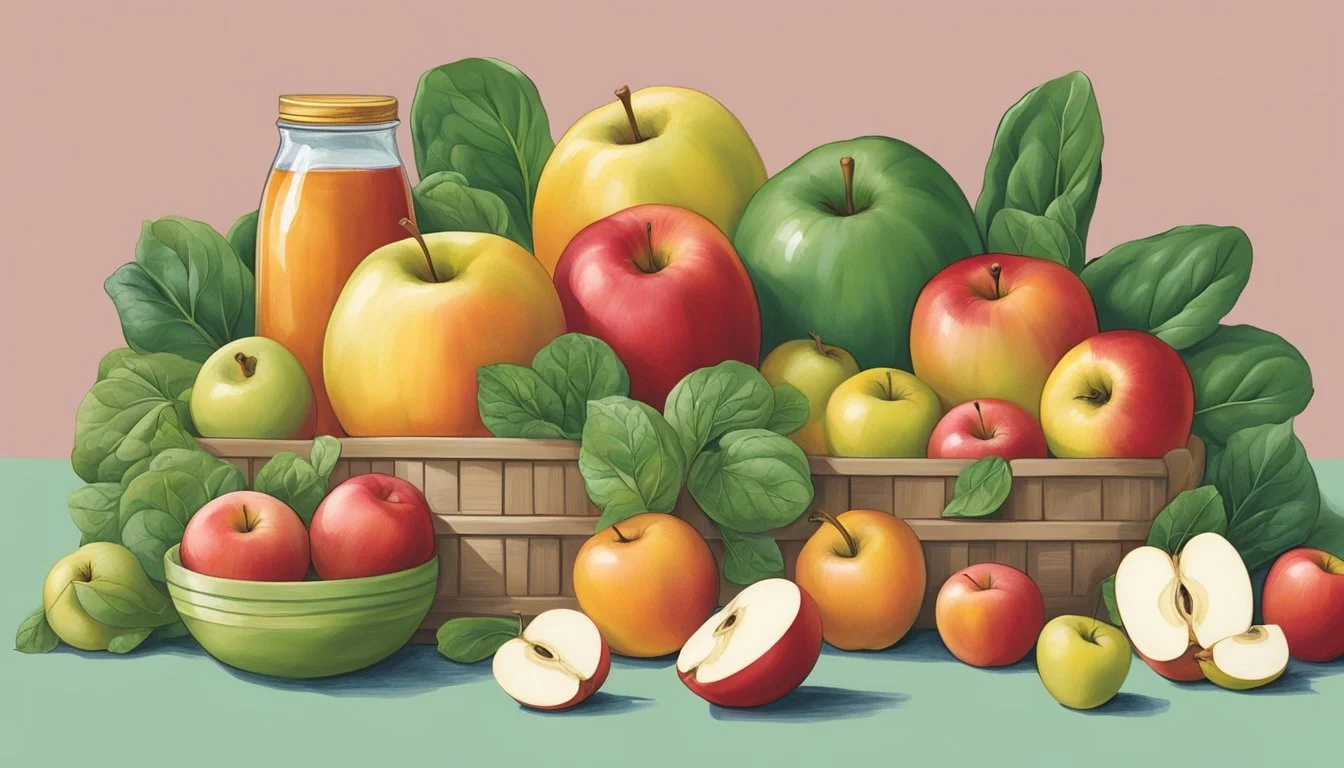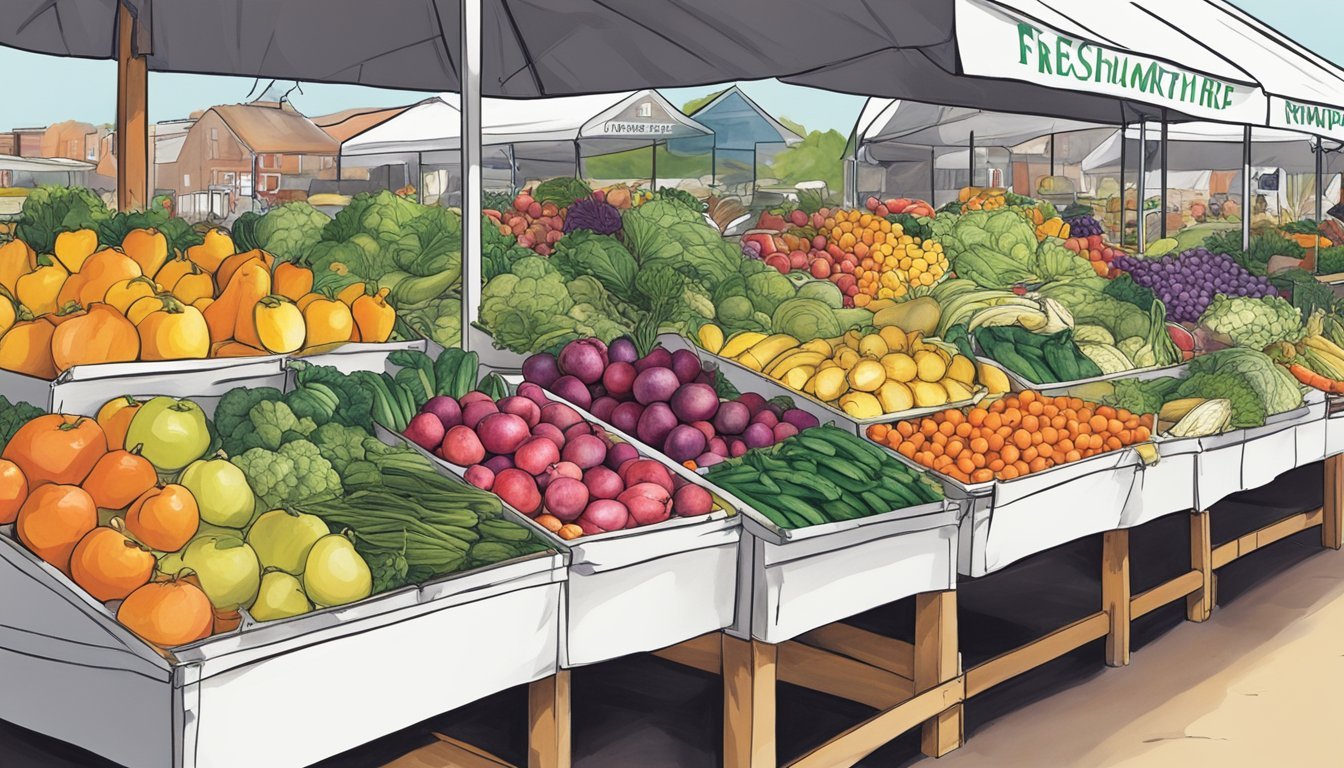New Hampshire Seasonal Fruit & Vegetables in March
Your Guide to Local Produce
This Article is Part of our New Hampshire Seasonal Fruit & Veg Calendar
March in New Hampshire is a transitional period for agriculture as winter begins to loosen its grip and signs of spring emerge. While the climatic conditions of New Hampshire lend to a shorter growing season, March typically doesn’t see a large variety of fresh local produce due to the lingering cold. Nonetheless, root vegetables and hardy winter greens often remain available, demonstrating the region's ability to yield produce even in the colder months.
As the ground slowly thaws, one might find the last of the winter storage crops, such as potatoes, carrots (how long do carrots last?), and onions, being offered by local farmers. These staples are known for their long shelf life and versatility in various culinary applications. March is also a time when growers prepare for the upcoming seasons, starting seeds indoors and gearing up for the warmer weather that facilitates the growth of a more diverse array of fruits and vegetables.
Greenhouses and cold frames begin to show promise by providing an environment for early lettuces and herbs. These facilities extend the growing capabilities within the state, ensuring that even in early spring, residents and chefs looking to source locally can find fresh, albeit limited, produce. This month reflects a period of anticipation and planning for both farmers and consumers eager for the bountiful harvests that come later in the year.
Understanding New Hampshire's Local Seasonality
New Hampshire's climate plays a significant role in the seasonality of its produce. The state experiences four distinct seasons: spring, summer, fall, and winter, each bringing its own harvest schedule for local fruits and vegetables.
In March, residents and visitors are in the tail end of winter, which generally results in a limited selection of fresh, locally-grown produce. The focus during this time is often on storage crops and hardy winter greens that can survive the cold climate. However, as the region transitions into spring, a broader variety of fruits and vegetables begin to become available.
The gardeners and farmers of New Hampshire are known for their ability to adapt to the shorter growing season and extended cooler temperatures. Even though the window for growing is more compressed, they efficiently use it to cultivate a range of produce that peaks in freshness as the seasons change.
Here is a brief overview of what is typically available from New Hampshire's local farms in March:
Storage Vegetables:
Potatoes
Carrots
Beets (how long do beets last?)
Turnips
Winter Greens:
Collards
Spinach
Hardy Herbs:
Thyme
Parsley
Shortly, with the onset of spring, New Hampshire anticipates the arrival of early crops like asparagus, rhubarb, and green onions. While the selection may be more limited than the bounty of summer and fall, the state takes pride in the quality and taste of its March offerings. The seasonal eating habits reflect an appreciation for the produce that can withstand the cold and celebrate the coming warmth that ushers in a new wave of farming potential.
March Seasonal Fruits in New Hampshire
In March, the selection of local fruits in New Hampshire is limited due to the cold climate, with a few exceptions found in controlled environments or stored harvests. The highlight of this month is primarily on citrus fruits, which are at their peak of freshness, offering a burst of flavor and vitamin C.
Citrus Fruits
Citrus fruits are not locally grown in New Hampshire during March due to the climate, but they are still widely available and fresh in markets, having been transported from warmer regions. Fruits such as grapefruits, oranges, tangerines, mandarins, and lemons are popular for their juicy zest and health benefits, particularly their high vitamin C content.
Grapefruits: A tangy source of antioxidants and vitamins.
Oranges: Sweet and juicy, perfect for eating fresh or juicing.
Tangerines: Smaller and sweeter than oranges, usually easy to peel.
Mandarins: A group including tangerines, with a sweet and less acidic taste.
Lemons: Often used for their juice and zest in various culinary applications.
Tree Fruits
While most tree fruits are not in season locally, some stored varieties like apples and pears from the previous year's harvest might still be available. These fruits are often used in baking or making warming dishes that are suitable for colder weather.
Apples: Stores well and versatile for cooking or raw consumption.
Pears: Can be found fresh in some markets, smooth and sweet when ripe.
Berries and Exotic Fruits
Local berries are not in season in March, however, exotic fruits such as kiwi, mango, and others may be imported during this time. These fruits can add a tropical twist to a fruit salad or serve as a fresh snack, although they are not grown locally.
Kiwis: Fuzzy fruit rich in vitamin C and fiber, with a bright green flesh.
Mango: A juicy, sweet fruit with a unique flavor, often enjoyed on its own or in desserts.
March Seasonal Vegetables in New Hampshire
March heralds the transition from winter to spring in New Hampshire, bringing a fresh selection of seasonal vegetables to the forefront. Locally grown produce offers enhanced flavor and nutritional benefits due to minimal transport time.
Leafy Greens and Cabbage
During the early spring, leafy greens such as kale, lettuce, and spinach start to make their appearance in local markets. These vegetables are not only versatile in the kitchen but also are packed with vitamins and minerals. One can find:
Kale: Rich in vitamin C and K, ideal for salads (What wine goes well with salads?) and smoothies.
Lettuce: Comes in various types, perfect as a base for salads.
Spinach: A nutrient powerhouse, great for cooking or as a fresh salad ingredient.
Cabbage, another March staple, is robust and can be cooked or used fresh in dishes like coleslaw, contributing crucial nutrients such as vitamin B6 and folate.
Root Vegetables and Tubers
Root vegetables remain a mainstay in March due to their storage viability and richness in essential nutrients. These include:
Carrots: Sweet and crunchy, good for snacking, roasting, or in soups.
Beets: Earthy flavor, suitable for roasting or as a salad topping.
Tubers like potatoes are still in season and incredibly flexible in their culinary uses, ranging from mashed potatoes to potato salad. They are a comforting source of vitamin C and potassium.
Farmers' markets and local co-ops in New Hampshire will usually have these fresh, in-season vegetables readily available throughout March.
Preparing Seasonal Produce
In March, New Hampshire's seasonal produce offers a variety of fresh flavors and nutrients that can be maximized through different preparation methods. Whether one is creating a crisp salad or a hearty casserole, the freshness of the ingredients is paramount.
Salads and Light Preparations
Fresh salads in March take advantage of early spring greens and root vegetables. Dressings made with olive oil can complement the natural flavors of the produce. For instance:
Arugula: Rich in vitamins and with a peppery taste, this leafy green is ideal for a fresh salad.
Carrots: Grated or thinly sliced, carrots add crunch and sweetness to salads.
List of Ingredients for a Fresh March Salad:
Arugula
Carrots
Olive oil (for dressing)
Cooking for Warmth and Comfort
Longer cooking methods can bring out the sweetness and tenderness in March vegetables, providing warmth and comfort during the tail end of winter.
Roasted root vegetables: Enhance their natural sugars and add depth to their flavor.
Casseroles: Incorporate seasonal vegetables for a satisfying meal.
Suggestions for Warm Dishes:
Roasted carrots and turnips with herbs
Chicken casserole with parsnips
Healthy and Energizing Options
Steaming vegetables preserves their nutrients and color, making for vibrant and healthful dishes.
Steamed broccoli: A great source of vitamins and minerals, perfect for a side dish or as an addition to pesto.
Soups: Utilize the full range of available produce to create nutrient-dense meals.
Ideas for Nutrient-Rich Preparations:
Broccoli steamed and tossed in homemade pesto
Pureed root vegetable soup with a swirl of olive oil
All these methods highlight the versatility of March's seasonal produce in New Hampshire, ensuring dishes are not only full of flavor but also beneficial for health.
Farming and Harvesting Practices
In New Hampshire, March marks a transition period within agricultural operations as farmers prepare for the upcoming growing season. Farming practices this month involve meticulous planning and execution as the soil thaws and daylight hours increase. Focus shifts toward tending to young plants in greenhouses where the controlled environment aids in early growth, protecting them from the still-chill external conditions.
Harvesting is minimal during March; however, farmers utilize greenhouses to extend the growing seasons of certain produce. With the protection from frost, tender stems and leaves develop in a nurturing environment, away from the harsh outdoor elements. Although most trees are not yet in bloom due to the cold climate, they are often pruned during this time to promote healthy growth and maximize the forthcoming harvest.
Here is a brief overview of harvest dates and practices for this period:
Crop Type Harvest Practice Start Date Stored Produce Monitoring and distribution Early March Greenhouse Crops Temperature control, irrigation Throughout March
Farmers remain attentive to their perennial plants, including fruit trees, ensuring that they are well-maintained and pruned correctly to support a fruitful harvest later in the year. Agriculture in New Hampshire adapts to the seasonal shifts with practices that underscore the importance of timing and technique in farming.
Sustainability and Local Agriculture
Sustainable practices in New Hampshire’s agricultural sector underscore the importance of local produce and careful resource management. Local farmers are increasingly embracing reduced-till and no-till practices, as evidenced by an increase to 5,535 acres of land being managed under these environmentally friendly techniques. These methodologies not only preserve soil structure and reduce erosion but also conserve water and reduce runoff.
With sustainability at the forefront, New Hampshire agriculture is adapting to climate challenges. Farmers are exploring climate resiliency strategies to protect their yields, ensuring that local communities have access to fresh, seasonal produce, including March offerings which may be limited but still important.
Pest management is another component of sustainable agriculture. Local growers integrate practices such as crop rotation and natural predators to control pests, aiming to minimize the use of harsh chemicals that could damage the environment.
Local food systems are integral to New Hampshire's agricultural landscape, reducing transportation requirements and therefore lowering greenhouse gas emissions. Supporting local also means fresher produce for consumers and a stronger local economy.
Water usage in agriculture is an ever-present concern, especially as climate patterns shift. New Hampshire farmers are increasingly employing water conservation measures, such as drip irrigation, to make the most efficient use of this precious resource.
Through a combination of sustainable practices, New Hampshire's agricultural community is working diligently to ensure they can continue to provide fresh, local produce while simultaneously stewarding the environment.
Nutritional Benefits of Seasonal Eating
Eating fruits and vegetables in their natural growth season can enhance their nutrient content. Seasonal produce is often picked at the peak of its freshness, ensuring a higher density of vitamins and minerals compared to fruits and vegetables that may have been harvested early for shipping and long shelf life.
For example, citrus fruits, which are in season during March in New Hampshire, are a rich source of vitamin C. This nutrient is essential for the maintenance of skin health and immune function. Consuming citrus fruits from local growers when they are naturally ripening optimizes the vitamin C content.
Nutrients: Seasonal fruits and vegetables provide a variety of essential nutrients. They can offer a more complex range of vitamins and minerals due to the reduced time between harvest and consumption.
Health: Integrating seasonal fruits and vegetables into one's diet can contribute to improved overall health. The freshness of the produce may translate into more effective absorption of nutrients by the body.
Vitamin C: Foods high in vitamin C, like oranges and kiwi fruits available in March, help protect against immune system deficiencies and cardiovascular disease.
The diversity in diet offered by seasonal eating also supports health by ensuring a broader spectrum of nutrients. This variability helps prevent nutritional imbalances and promotes a robust immune system.
Lastly, locally sourced, seasonal fruits and vegetables may contain fewer pesticides and be less processed, which adds to their nutritional advantages. Consumers are not only enjoying produce at its flavorful best but also contributing to a healthier body and a more sustainable food culture.
Exploring State and Regional Agricultural Resources
In New Hampshire, the state supports agriculture through various programs and initiatives. The New Hampshire Department of Agriculture, Markets & Food plays a crucial role in supporting local farmers. They provide grants and create platforms to educate consumers on what is in season, where it is being grown, and who is growing it.
Local Extension services offer charts and guides that detail the availability of fruits and vegetables by harvest dates. For instance, during March, one might find that the variety of locally harvestable produce is limited due to the cold climate. However, consumers can still access storage crops such as apples and potatoes, and some greenhouses may provide hardy greens.
Organizations Offering Resources:
NH Department of Agriculture, Markets & Food: Provides funding and educational resources for consumers and farmers alike.
Extension Services: Releases harvest availability charts for better planning and consumption of local produce.
Available Resources:
Harvest Charts: Guides detailing when each fruit and vegetable is in season.
Educational Webinars: Focused on beginner land planning, pest management, and more.
Consumer-Facing Websites: Aim to connect consumers with local vegetable and berry growers.
These resources help foster an understanding of sustainable agriculture practices among New Hampshire residents and guide them in their seasonal food choices. Such initiatives not only support the local economy but also aim to ensure that the community benefits from fresh, nutritious produce year-round.
Recipes and Culinary Inspiration
New Hampshire's March bounty offers fresh and comforting options perfect for crafting both hearty meals and light, revitalizing dishes. Utilize seasonal produce like apples, beets, cabbage, carrots, and kale to bring a touch of the garden to the table.
Main Dishes
Hearty Apple Chicken Casserole: This dish makes excellent use of New Hampshirite apples by pairing their sweetness with savory baked chicken. Incorporating a blend of local herbs enhances the flavors, creating a satisfying main course.
Root Vegetable Pasta (how long does pasta last?): A rustic pasta dish comes to life with the addition of roasted beets and carrots. They lend a vibrant color and earthy taste that complement any creamy pasta sauce (how long does pasta sauce last?), offering a comforting meal perfect for the tail end of winter.
Side Dishes and Accompaniments
Kale and Cabbage Coleslaw: The crisp textures of kale and cabbage combine in a refreshing slaw. A light apple cider vinaigrette dressing marries the flavors, making a vibrant accompaniment to any main dish.
Mashed Potatoes with Roasted Garlic: Potatoes, still in good supply, mash beautifully with roasted garlic and a hint of fresh herbs, resulting in a creamy and aromatic side that elevates traditional mashed potatoes to a new level of flavor.
Light and Fresh Options
Spring Pea and Radish Salad: Bringing a burst of freshness, peas and radishes make a delightful salad. Add thinly sliced apples for a subtle sweetness and a crunchy texture that embodies the awakening of spring.
Green Apple Smoothie: For a quick, nutritious option, blend tart green apples with kale. Sweeten with a touch of local honey and enrich with yogurt to create a rejuvenating smoothie that's both healthful and energizing.










